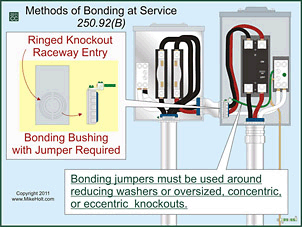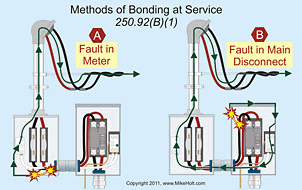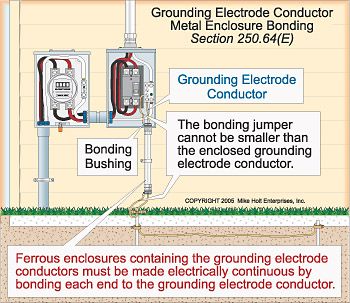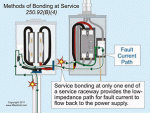green2012
Member
- Location
- highland park, il
I have a 200 amp overhead service installation. I have a 200 amp meter with disconnect (breakers) on the exterior and a 200 amp main disconnect inside. Im required to install grounding bushings in several locations. I'm gonna walk through the installation starting at the top and say how the grounding bushings are utilized. The 2" rigid comes into the meter via a hub (no G-bushing required), a 2" rigid leaves the meter entering the home and landing in the panel ( G-bushing on both sides ), a 3/4" leaves the panel and goes to cold water (G-bushing on panel side/ ground kit at cold water), there is also a 3/4 rigid exiting the meter to ground rod.( Gbushing)
A #6 runs from the ground rod- gets a portion stripped and looped through the grounding bushing and lands on the ground bar inside the meter. From the ground bar inside the meter a #4 runs up and (1) loops through the ground bushing, leaves the meter, and (2) gets looped through the ground bushing on the panel side. It runs through the panel and (3) looped through the ground bushing on the 3/4 before leaving to land on the cold water at the other side.
My question is about the loop labelled (2). Im wondering if that grounding bushing should bond to the panel rather then the grounding electrode wire. The meter housing is effectively grounded by its ground bar where the ground rod and cold water electodes start, and the point of all the other grounding bushings are to ensure that the pipes are grounded effectively. The panel doesnt "look" effectively grounded. Thoughts?
A #6 runs from the ground rod- gets a portion stripped and looped through the grounding bushing and lands on the ground bar inside the meter. From the ground bar inside the meter a #4 runs up and (1) loops through the ground bushing, leaves the meter, and (2) gets looped through the ground bushing on the panel side. It runs through the panel and (3) looped through the ground bushing on the 3/4 before leaving to land on the cold water at the other side.
My question is about the loop labelled (2). Im wondering if that grounding bushing should bond to the panel rather then the grounding electrode wire. The meter housing is effectively grounded by its ground bar where the ground rod and cold water electodes start, and the point of all the other grounding bushings are to ensure that the pipes are grounded effectively. The panel doesnt "look" effectively grounded. Thoughts?






